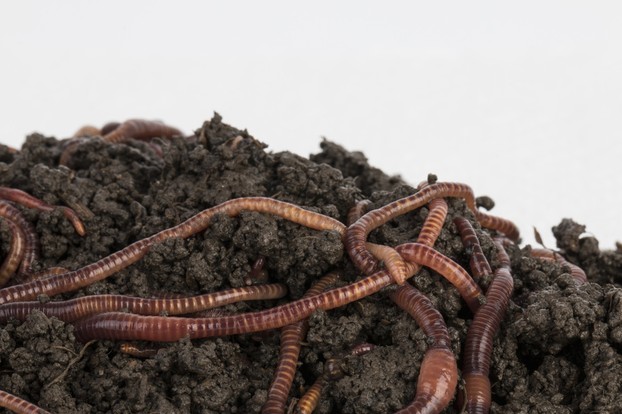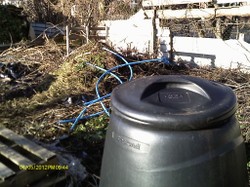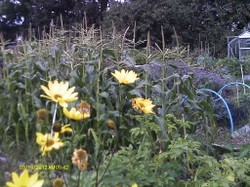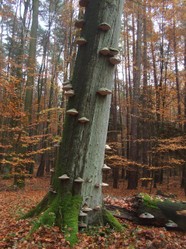Compost bins and heaps of various sizes and shapes are a common sight in gardens and allotments. Usually tucked away at the rear of the plot against the hedge, this dark and crumbly source of humus is a great friend of the organic gardener, for it provides a range of blessings to the soil and to those who till it. But there are differing kinds of compost, each of which has its own particular value and use at differing stages of a plant's growth, and they can be made in different ways.

Dark Gold: Garden Compost
by frankbeswick
Compost is a wonderful addition to a garden, but there is a variety of types of it.
Black Gold.
If you take a look at the advertisement below you see a compost tumbler, a modern kind of compost bin that can speedily turn vegetable waste into rich, black compost. So how does this happen? Compost making is a natural process in which vegetable matter is broken down in the presence of oxygen,water and a vast and complex range of bacteria and fungi, all of them microscopic. Those of us who have seen a compost heap steaming and felt how hot it becomes will realize that the heat is the product of combustion, in which oxygen is used up. By turning the heap oxygen depleted parts of the compost are re-exposed to oxygen, The traditional way of doing this is to fork over the compost heap, and alternatively some gardeners do so by having a series of compost bins in a row. They fork the decaying vegetable matter from one bin to the other,exposing it to the air in the process and thus accelerating the decay process. The compost tumbler that you see enables the vegetable matter to be exposed to more air than a conventional compost bin can provide.
Well-made compost is black and friable.The word friable means crumbly, for when it has finished its decay process it should crumble in your fingers as you feel it. It therefore will have a good crumb structure. The blackness/darkness comes from the presence of humus, a black and exceedingly complex organic colloid that is still incompletely understood by scientists. Humus is the last stage of decay of organic matter before it breaks down into its constituent elements, and it serves an important function in soil health. The complexity of its structure enables it to hold nutrients and water in the soil, and it also serves as a glue that binds the soil particles together, so without humus the mineral particles of the soil would not cohere and would be washed away as rains fall on the ground. It also serves as a rich source of plant nutrients, for without the compost these might be lost to the soil. It is a defence against pests, as a soil to which compost has been added strengthens plants' immune systems, which then enable them to resist pest infection more easily.
The compost pile is a huge network of life, a vast array of living creatures interacting in a network so complex that science has not yet fully grasped it. At the heart of the system are the thermophiles, heat-loving bacteria that consume the food and air in the pile, and whose waste [manure] is the basis of the richness of the compost. The life of the compost heap undergoes evolution as the eco-system of the compost pile changes as the oxygen levels are used up, adding a further layer of complexity to an already baffling ecosystem. In my compost heap I have seen frogs hunting. It is quite simple really, large slugs eat compost, frogs eat slugs. So that's where the frogs go to dine. On the other hand,a sign that a compost heap is going cold is the presence of wood lice, but this is generally when the composting process is coming to an end.
Composting with Worms.
The worms that you have in your compost bin are not earth worms, but compost worms, which prefer to live in the warm conditions of the heap and which die outside of them. The most common worm species is the brandling, known as tiger worms because of their stripes, but blue nose worms are also suitable for compost heaps, however, they are not as robust as brandlings are.
Worms live in any compost bin, but there are specialist wormeries. A worm composter [wormery] can take stuff food stuff that a conventional compost bin cannot. For instance, you cannot put cooked food in a conventional compost bin, as rats are attracted to cooked food, but you can put it into a wormery. A worm composter needs to be fully enclosed to prevent the worms escaping, but a conventional compost bin should have no base so that the compost touches the soil to enable the soil bacteria to accelerate the composting process. You can put any amount into a compost bin/heap, but worm bins should have material added in small doses to prevent over-facing the worms.Worm composters need an occasional addition of a handful of lime so so that the worms will not suffer from excess acidity, whereas conventional bins do not. The lime keeps the environment sweet for them. Avoid adding citrus rind to the wormery, as it is acidic
Worm compost is very rich, so rich in fact that it should only be applied in small doses, but it is very rich and is great for soil fertility. There is, however, second product, a liquid one. This is drained off by way of a tap at the base of the bin. Beware, it stinks disgustingly, but it is a very rich plant nutrient that should be applied dilute to the crops through a watering can.
To begin the worm bin you need a supply of worms and a neutral medium at the bottom for the worms to hide in,such as paper, cardboard or straw. Be aware, worms hate light and burrow to avoid it. Hence,if you open the bin they scuttle to safety deep deeper down. So what you need to do is to provide a bedding of shredded paper or straw for the worms to hide,so they will not need to scuttle. The worms will always dwell in the top six inches of the bin, where they make the wonderfully rich compost on which the garden thrives.
Worm Compost
 Worm compost kolidzei |
Bokashi.
This is a Japanese innovation. Bokashi is a kind of bran that is mixed in with the food remains.There are advantages and disadvantages to using it. The advantage is that it makes compost speedily using small quantities of waste food. The disadvantage is that you need to keep on purchasing the bokashi bran to sustain the compost production, whereas a conventional composter can be left to its own devices with only some turning to aerate it.
Bokashi involves a combination of grain, molasses and EMOs, effective micro-organisms, a combination of bacteria and fungi selected to produce maximum effect and speed. The technique is to add material in layers, a layer of waste then a layer of bran and so on. The process takes a few weeks. Some growers buy more than one bin, so that they can maintain a supply of high quality compost throughout the year,
Specific Kinds of Compost
There are different composts for the stages of growth in a young plant's life. There are also different types of compost for plants of differing kinds; seed compost,potting compost, multipurpose compost and ericaceous compost.
Seeds contain their first supply of nutrients in themselves and so do not need a rich compost to grow in, but when you pot them on you can place them in potting compost, which is somewhat richer than seed compost. If your goal is to transplant them outdoors they will them go into the soil, but if you are growing in pots you can transplant theme into pots of multi-purpose compost, which can be brought in from compost companies.
I have two compost heaps for garden materials and a bin for kitchen waste,which is richer than garden compost. The compost heap should contain a mix of green and woody materials, and chopped paper and cardboard have their place. Too much grass and the heap can become too hot too quickly and exhaust the available oxygen,leaving the grass as a grey decomposing mess. Too much woody material means that the heap does not warm up enough to compost the materials in it. Currently I am allowing the allotment committee to place the cuttings from our new grass roadway onto my compost heap, but there is a bit too much grass on it at present, so I am taking it up and spreading it as mulch around my fruit trees, which will nourish the soil and keep the weeds down. The trees are already mulched with wood chip, so together the two should form a balanced soil improvement strategy.
The final kind of compost that I want to mention is ericaceous compost, which I use on my blueberry bushes. Blueberries, like cranberries, require a sol more acidic than the soil that I have on my plot, so I grow them in pots filled with ericaceous compost, which has a pH lower than my soil has. I get a yearly crop of blueberries from this compost.
Compost is a great soil enricher and is particularly useful for growers who have limited access to animals for their manure. It is better than fertilizer, which only enriches soil. but does it bind it together and therefore used alone makes it liable to be washed away. I use some fertilizer, but the basis of my growing is compost, which I also augment with pelleted cow and chicken manure.
You might also like
Revamping the AllotmentNo garden design is for ever, and this year I am having to make some changes ...
The living soil: encouraging soil fungiIn recent years the role of fungi in plant growth has been increasingly recog...









 Pilgrimage. A reviewon 06/15/2025
Pilgrimage. A reviewon 06/15/2025
 Leo the Fourteenthon 05/09/2025
Leo the Fourteenthon 05/09/2025
 The Melsonby Hoardon 03/25/2025
The Melsonby Hoardon 03/25/2025



Comments
No. They are both useful.
Thank you for your comments below, on Jun 17, 2022, in answer to my previous same-day observation and question and on Jun 24, 2022, in answer to my previous, previous-day observation and question.
Are compost tea and worm liquid competitive with one another as nutrient-providers of near-same, not-same or same nutrient amounts and types?
There is no standard practice on the subject,but I think that outdoor is the more common option.
It's popular on this side of the (Atlantic) pond to do worm composting in big, lidded plastic containers that fit in the space between a kitchen, mudroom, pantry or utility-room countertop and the bottom of wall cabinets (for canned goods or for glasses and plates).
Sometimes gardeners who practice worm composting more indoors than outdoors opt for compost tea over worm liquid.
Would you all east Atlantic ponders do worm compositing strictly indoors, strictly outdoors or both?
Strictly speaking, compost tea and worm liquid are not the same, but they are related in that they are both liquid sources of nutrients.
frankbeswick, Thank you for product lines, pretty pictures and practical information.
In particular, I appreciate your second paragraph under your subheading Black Gold. I focus so much upon the soil benefits that I forget how compost bolsters plant and soil food web immunities. So I particularly like your reminder.
Also, your next-to-last paragraph under your subheading Composting with Worms mentions that "Worm compost is very rich, so rich in fact that it should only be applied in small doses, but it is very rich and is great for soil fertility. There is, however, second product, a liquid one. This is drained off by way of a tap at the base of the bin. Beware, it stinks disgustingly, but it is a very rich plant nutrient that should be applied dilute to the crops through a watering can."
Would that I had re-read this wizzley before, not after, re-visiting your wizzley on soil enhancers, where I asked about compost tea!
Would this liquid referenced in the sentences that I quote here from this wizzley be compost tea (perhaps known under another name by you all east-ponders)?
There are different kinds of worms, but they are great soil builders. Worm casts [manure] are an important constituent of soil: and worms aerate soil making in healthy for plants, which take in oxygen in their roots.
Frank, here our local government once gave away plastic compost bins. They had to be picked up, or people not wanting them would have tossed them away. The reason was t keep landfills from taking on too much waste. So composting also helps with landfills.
I had not heard of worms being significant, but it makes sense.
Thank you for this, Angela. I taught gardening for a year in a special school for autistic teenagers, till the school ran out of money to pay me. I taught composting, but it is good of you to tell me that schools where you are have gardens and teach about compost and natural fertilization. Some schools here have gardens, but not all take them seriously.
I will share with you one of the frustrations of my past. I was considered a bright boy, so I only was allowed to study one craft, woodwork [but my astigmatic eyes made fine woodworking an impossible chore.] The less bright boys did woodwork and metalwork, and the low ability lads did gardening, which was not valued. They had the late Mr Bradshaw, a brilliant teacher. I used to look at the low ability lads going happily to his lessons in the school garden while I was not allowed to join them. I had to privately train in gardening years later.